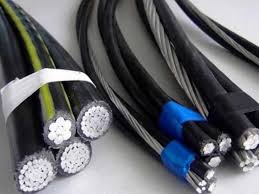Cross-linked polyethylene insulated cables have good mechanical properties, convenient installation and maintenance, excellent insulation performance, larger transmission capacity than oil-paper insulated cables of the same cross-section, simple production process, conducive to mass production, and can transmit power to areas that cannot be reached by overhead lines And other advantages, so it is increasingly widely used in power systems and constitutes an important part of the transmission and distribution network.
Cross-linked polyethylene insulated cables can choose a variety of laying methods according to engineering conditions, environmental characteristics, cable type and quantity, combined with the requirements of reliable operation, easy maintenance, and the principle of reasonable technology and economy, such as direct buried laying, pipe laying, Shallow trench laying, trench laying, tunnel laying, etc. The use of buried aerial bundled cables ASTM B231 to realize the power transmission and connection between two or more electrical devices can save space and line corridors and reduce the consumption of valuable land resources. The selection of qualified cables and accessories, laying and installation in accordance with the requirements of standards and specifications, and strict guarantee of construction quality are the prerequisite and guarantee for the safe and reliable operation of cable lines.
1. Water ingress analysis inside the cable
Analysis of Causes of Water Ingress As the complete new cable adopts multiple waterproof and water-blocking designs in the internal structure and materials, there will be no internal water ingress under the condition that the two ends are sealed. Aiming at the cause of water ingress into the 35 kV cable, this article conducts an in-depth analysis in connection with the cable manufacturing, transportation, laying and installation links:
(1) Water enters during the production of ABC ASTM B231. The main production process of the cable supplier is: first, a single compact conductor core is formed by wire drawing and twisting; then the conductor semi-conductive shield, XLPE insulation and insulated semi-conductive shield are simultaneously extruded on the outside; then winding Protective tape and metal shielding layer; combine the three cable cores and add fillers to form a cable; wrap the inner sheath and armored steel tape on the outside of the three-core cable, and finally squeeze a layer of polyvinyl chloride outer sheath. In order to control the quality of cable production, the manufacturer adopts many methods in the production process to prevent moisture from penetrating into the cable. For example, advanced production equipment is used to achieve three-layer co-extrusion of conductor semi-conductive shielding, insulation, and insulating semi-conductive shielding; XLPE insulation adopts dry The cross-linking method performs cross-linking. If you strictly abide by the entire production process, with the current advanced technology and production equipment, there will be no water ingress into the cable when manufacturing cross-linked cables.
(2) Water ingress during transportation and construction. There are three possible situations when water enters the cable: one is that the outer sheath of the cable is broken during transportation and installation, and it is exposed to rain or water so that water enters the outer sheath of the cable; the other is that the cable is accidentally used during construction. The head is damaged and water has entered. The third is that when it rains during installation, construction workers forget to cover the sawn cable ports, causing rainwater to flow into the cables.
1.2 Analysis of the influence of water ingress In the first case, water enters the inside of the cable through the crack in the outer sheath, and the steel strip of the armor layer will quickly rust, and then the water will penetrate into the filling material to make it absorb water and become damp. The phase-to-phase insulation of the cable has an impact, but has little effect on the single-phase insulation. In the second and third cases, water can directly enter the bare conductor. If you cut the cable conductor core and observe its cross section, you will find that there is water flowing out of the multi-strand core. If the incoming water is not cleaned up in time, after the cable is energized, water branches can be generated on the side of the main insulation close to the conductor core, which will lead to the generation of branches, and finally lead to the breakdown of the main insulation. Because of the serious consequences of water ingress in the cross-linked cable, as long as water in the cross-linked cable is found, immediately stop laying and installation, analyze the cause of the water in detail, find out the aerial bundied cable(ABC) damage as soon as possible, and take appropriate measures to deal with it in time.
